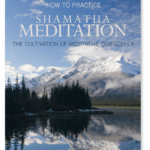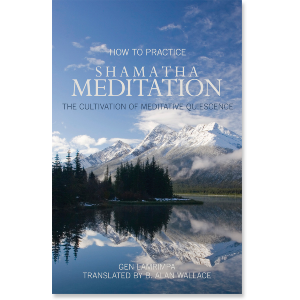| The following article is from the Autumn, 2011 issue of the Snow Lion Newsletter and is for historical reference only. You can see this in context of the original newsletter here. |
Go for the stability, then the clarity
Q: How can one develop greater clarity without yielding to scattering, tensing up the mind, and giving rise to stress?
A: As one is cultivating stability, one should be especially on guard for the arising of laxity. For the development of clarity, the mind needs to be elated, aroused. This can be done by means of reflecting on uplifting subjects, the fully endowed human life, the benefits of shamatha, and the like. As you set forth in the meditation, you must alternate the emphases in the practice: being on guard for the arising of laxity and watching carefully the state of your clarity; and being on guard against excitement or scattering and checking on the strength of your stability.
So, at first you are emphasizing one, then the other, and no one but you can determine what the suitable level of awareness is. When you are developing the strength of clarity, there is a tendency for excitement to arise. If you feel it arising, taper off a bit on the clarity side. Likewise, when you are going for stability, you are prone to laxity arising. When you see that happening, then you want to uplift the mind. What you want is to balance right in the middle. The middle is something that can only be sought out by means of your own experience.

When I increase my enthusiasm, going for clarity, my mind gets excited; whereas when my mind gets more stable I tend more towards laxity.... What am I to do?
Essentially, we find ourselves in the predicament of Chandragomin (Candragomin), who wrote a verse that can be paraphrased: When I increase my enthusiasm, going for clarity, my mind gets excited; whereas when my mind gets more stable I tend more towards laxity. I find it very hard to find that middle ground. What am I to do?
What you do is gradually seek out that middle path by means of your own experience. The more you practice, the more experience you acquire, and the more clarity you gain as to how to develop your practice.
One thing to remember as you enter the first stages of practice is that at the outset there tends to be a strong urge to get better clarity fast. Don't go for it. Be satisifed with a rather poor quality of clarity and really go for stability. The appropriate process is to start by trying to establish stability in a very gradual and gentle way. Upon that basis, clarity can then be developed. In the early stages of your practice it may be that clarity is surprisingly good.
Because the mind is so prone to attachment and excitement you may feel the irresistible urge to go for even more clarity. It's a trap. If you follow that route, the clarity will become an obstacle.
Therefore, first of all, emphasize stability.
adapted from How To Practice Shamatha Meditation


